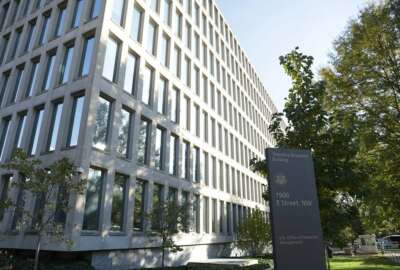
How agencies are trying to keep early-career employees in federal jobs
OPM is prioritizing early-career recruitment, as the federal government trails the private sector in its percentage of millennial and Generation Z employees in ...
Best listening experience is on Chrome, Firefox or Safari. Subscribe to Federal Drive’s daily audio interviews on Apple Podcasts or PodcastOne.
With millennial and Generation Z employees projected to comprise a large portion of the U.S. workforce by 2025, the Office of Personnel Management is pushing forward on more incentives to recruit and retain early-career federal employees.
It’s particularly important right now, said OPM Director Kiran Ahuja, because of the current imbalance in how many early-career employees there are in the federal workforce, versus the nationwide workforce.
“We track much lower than the private sector by a wide margin,” Ahuja said at a National Academy of Public Administration event on Nov. 2. “Attracting early career talent is a priority for me. It is a priority for the President’s Management Council. It’s a central part of the President’s Management Agenda.”
For the time being, much of the approach to fixing these early-career recruitment challenges may come through smaller scale efforts, Ahuja said, rather than a full-scale transformation of the federal recruitment process.
“There are folks who have talked about wholesale civil service reform, but I won’t hold my breath for that,” Ahuja said.
Without comprehensive federal workforce reform, there are still some ways agencies can make changes for hiring and recruitment practices. For example, OPM added two new hiring authorities last year — the post-secondary hiring authority and the recent graduate hiring authority. Ahuja also said OPM plans to help agencies use ideas from expedited hiring projects, such as the six-month hiring spree under the Bipartisan Infrastructure Law, in their internal recruitment processes.
“We also know this transformation is urgently needed given the rapidly changing work environment and new expectations from employees,” Ahuja said.
Federal internships are another instance of how OPM is trying to help agencies get early-career employees in the door. For fiscal 2023, the Biden administration set a goal to hire 35,000 federal interns. It’s a number of interns that the federal government has achieved before, back in 2010. But more recently, the number of federal internships has plummeted. A central part of the Biden administration’s goal for this coming year also involves expanding paid internship opportunities.
“Interestingly enough, [paid internships are] a novel concept here in Washington, D.C., and the federal government, but this is tied to our diversity, equity, inclusion and accessibility agenda,” Ahuja said. “We’re working on guidance right now, that’s coming out very soon, to encourage agencies to pay their interns.”
Other programs aiming to recruit early-career workers are also gaining traction. In one example, the Presidential Management Fellowship program, a two-year federal program for graduate students, just broke a record with 10,000 applications this year.
But early-career hiring will only become a more pressing issue for the federal workforce over time. Right now, less than 7% of the federal workforce is under the age of 30. Gen Z employees, those ages 25 and under, make up about 1.6% of the federal workforce. That’s compared with the same age group comprising 9.1% of the nationwide workforce, according to Paul Pietsch, the Partnership for Public Service’s senior manager for federal workforce research.
“There is an imbalance there,” Pietsch said at a FedInsider event on Nov. 8. “This really underscores that the federal government needs to do a better job getting younger people into government, getting them excited about public service, and providing them the resources, motivation and support to keep them in government.”
Notably, Pietsch added, many Gen Z employees only joined the workforce after the start of the COVID-19 pandemic, which drastically increased telework and remote work in the U.S. As a result, many early-career employees see hybrid work or remote work as the baseline for an employer.
“The notion of being in the office five days a week is somewhat foreign for some younger people,” Pietsch said. “Although some Gen Z do want to be in the office, so they can’t connect to their colleagues and feel that they belong, many also expect flexible work — that’s their only experience.”
But early-career employees aren’t the only ones that federal human capital leaders are tracking, and they’re also not the only ones looking for more flexible remote or telework opportunities. The Generation X workforce makes up the largest portion of the Energy Department’s workforce, for instance, according to Jacqueline Clay, the agency’s deputy chief human capital officer.
“There are definitely differences in the way that people operate at Department of Education based on those generational differences,” Clay said at the FedInsider event. “[Gen X employees] are more focused on family, so a lot of them enjoy the remote work environment. And being able to build those family relationships is still something they’re giving back to public service.”
In another instance, Nuclear Regulatory Commission is trying to incentivize both early-career and mid-career employees by using rotational assignments. These temporary assignments are a growing trend for agencies, which let employees work at other organizations or on different projects to develop skills that can help them with their day-to-day work. But NRC Deputy Chief Human Capital Officer Eric Dilworth said rotational assignments have other benefits, too.
“It makes folks want to stay with the organization because they know they can get different opportunities and learn different things,” Dilworth said. “It’s going to help them develop [skills], help them get promoted – all the things they’re trying to do. That’s really helping with the mid-career folks. And then when newer workers come on board, and they see these opportunities … they know they’ll be able to cross train and do these type of things.”
And agencies have other benefits and incentives that they can leverage, to encourage more early-career employees to join federal service, according to Pietsch. The Public Service Loan Forgiveness program, for example, may be particularly helpful to those who only recently graduated from college and may have acquired student debt. He recommended first raising awareness of the PSLF program, as many don’t know it’s out there.
“But that’s not enough,” Pietsch added. “[Employees] also need to know how to apply, they need to be supported in that way. In 2021, for example, about a third of applications for the Public Service Loan Forgiveness program were incomplete. So people need that technical support to know how to complete the process.”
Copyright © 2024 Federal News Network. All rights reserved. This website is not intended for users located within the European Economic Area.
Drew Friedman is a workforce, pay and benefits reporter for Federal News Network.
Follow @dfriedmanWFED
Related Stories
OMB ‘heavily focused’ on early-career recruitment in President’s Management Agenda




